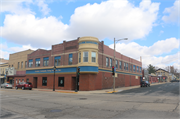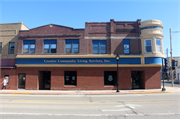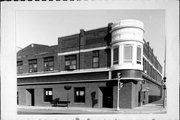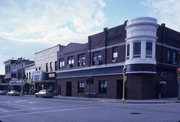Property Record
312/320 E MAIN ST
Architecture and History Inventory
| Historic Name: | Charles Miller Building |
|---|---|
| Other Name: | Unemployment Compensation Office |
| Contributing: | Yes |
| Reference Number: | 76461 |
| Location (Address): | 312/320 E MAIN ST |
|---|---|
| County: | Jefferson |
| City: | Watertown |
| Township/Village: | |
| Unincorporated Community: | |
| Town: | |
| Range: | |
| Direction: | |
| Section: | |
| Quarter Section: | |
| Quarter/Quarter Section: |
| Year Built: | 1910 |
|---|---|
| Additions: | C. 1925 |
| Survey Date: | 19862020 |
| Historic Use: | large retail building |
| Architectural Style: | Commercial Vernacular |
| Structural System: | |
| Wall Material: | Brick |
| Architect: | |
| Other Buildings On Site: | |
| Demolished?: | No |
| Demolished Date: |
| National/State Register Listing Name: | Main Street Commercial Historic District |
|---|---|
| National Register Listing Date: | 6/2/1989 |
| National Register Multiple Property Name: |
| Additional Information: | This building was built by Charles Miller for the family cigar-making business. A.F. Miller began making cigars in 1961. By 1880, his firm was manufacturing 225,000 cigars a year and was one of several leading cigar manufacturers in the city. This building, constructed in 1910, speaks to the success of the family business, later operated by Charles Miller. The Miller firm lasted well into the twentieth century, but gradually, as with the other cigar makers in the community, it died out later in the century. The Miller Building is significant as part of Watertown's commercial district under National Register criterion A, because it was built by the Miller family for their successful cigar-making business. Cigar-making was an important small industry in Watertown and several firms became the leading manufacturers in the late nineteenth century. Among them were the Wiggenhorn Brothers, the Schlueter Brothers, the Wilkowski Brothers, and the A.F. Miller Company. Both the Schlueter Brothers and the Wilkowski Brothers were located in small, rather nondescript buildings. The Wiggenhorn Brothers building at 104 W. Main St. is the most impressive of the small cigar factories operated by these firms. Because of its imminent demolition, though, the Miller building is the most impressive of these cigar factories left in Watertown. It is unusual that the main cigar-making firms housed their operations downtown, in commercial structures. Unlike other factories, cigar-making was tied significantly to Watertown's commercial district. The Miller building, built from the cigar-making profits and housing the firm in the early twentieth century, is a significant part of the commercial district in Watertown's downtown. Built of red brick in the early 20th century by the Miller Tobacco Company on the site occupied by its founder, Adolph Miller since the 1870s, the Miller building was constructed in two parts. Built in 1910 in place of the earlier frame structures, the main structure on the corner lot features a round wooden corner tower characterized by a classical entablature comprised of a plain projecting cornice trimmed by a row of dentils, a paneled parapet and friezes inscribed "1910" and "Miller." Rectangular windows with fluted pilaster mullions further characterize the tower. Paneled brick and cut-brickwork ornament the upper facade and east elevation that is divided vertically by applied brick pilasters extending above the roofline. White stone window lintels and sills linked by white stone belt courses divided the red brick surface horizontally. The rectangular windows on the second story are partially filled in. A brick rectangular pediment rises above the roof line of the section of the building located at 316 E. Main built in a similar manner. This Miller building also features plain paired rectangular windows and white stone accents. The Miller building has been altered by the addition of contemporary styled storefronts on both sections of the building, eliminating the original corner entrance bay. A more recent two-story addition has been added also, using similar construction materials. The Miller Building is important as an example of early 20th century comemrcial vernacular architecture influenced by the Neo-classical style. Although the building does not exhibit all the characteristics of the style, the Miller building does exhibit the idea of classical pediments supported by applied pilasters and has retained a corner turret featuring a classical entablature and fluted applied pilasters. Also, the Miller building is one of the few buildings in the commercial district and in the city as well to show definite Neo-classical influence. Good examples of the Neo-classical style in the city include the Public Library at 100 So. Watert (65-23), Bank of Watertown at 14 E. Main (62-24), the Archie Brothers Monument Works at 218 So, 1st, and the King House at 802 SO. 8th (38-11). Built to serve as the cigar factory for the Miller family enterprise in 1910, the Milelr building and the later addition on the west side has been altered extensively on the lower story of the facade, diminishing its architectural significance somewhat. |
|---|---|
| Bibliographic References: | (A) Building inscription. (B) Tax Records, City of Watertown, 1860-1910, Area Research Center, Library, University of Wisconsin-Whitewater. (C) Sanborn Insurance Map, City of Watertown, 1884, 1909, 1915. (D) "Revised Tariff of Rates for Watertown, Wis.," National Board of Fire Underwriters, April 13, 1876. (E) "City Had Second Largest Cigar Factory in State," Watertown Daily Times Centennial Issue, June 26, 1954, n.p. (F) Watertown City Directories, Watertown Public Library. |
| Wisconsin Architecture and History Inventory, State Historic Preservation Office, Wisconsin Historical Society, Madison, Wisconsin |




